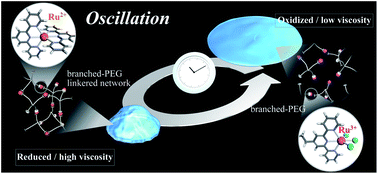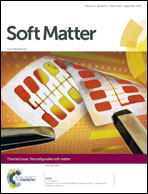Herein, we report an autonomous viscosity oscillation of polymer solutions coupled with the metal–ligand association/dissociation between Ru and terpyridine (tpy), driven by the Belousov–Zhabotinsky (BZ) reaction. The tpy ligand for the Ru catalyst was attached to the terminals of poly(ethylene glycol) (PEG) with different numbers of branches (linear-, tetra-, and octa-PEG). It is well known that mono-tpy coordination is stable when Ru is oxidized (Ru(tpy)3+), whereas bis-tpy coordination is stable when the Ru centre is reduced (Ru(tpy)22+). In the oxidized state, the three different polymers existed as solutions. In contrast, when the Ru centre was reduced, gels were obtained for the tetra- and octa-PEG owing to the formation of a three-dimensional polymer network through Ru–tpy coordination. Rheological measurements confirmed that the sol–gel transition occurred much more quickly in the octa-PEG system than in the tetra-PEG system, because of the requirement of fewer crosslinking points. The polymer solutions exhibited self-oscillation of absorbance and viscosity when BZ substrates were added to the solutions of Ru2+–tpy-modified tetra-/octa-PEG. This indicated that the Ru(tpy)22+ attached to the polymer ends could work as a metal catalyst for the BZ reaction. By increasing the number of branches from 4 to 8, the amount of crosslinking changed more remarkably during the oscillation, with a maximum value closer to that necessary for gelation. Thus, viscosity oscillation with a larger amplitude in the region of higher viscosity was achieved by using octa-PEG.

You have access to this article
 Please wait while we load your content...
Something went wrong. Try again?
Please wait while we load your content...
Something went wrong. Try again?


 Please wait while we load your content...
Please wait while we load your content...